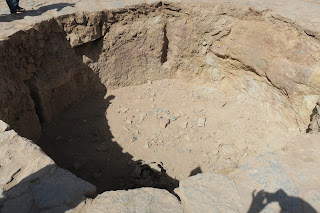A Dakhma (Persian: دخمه), also known as the Tower of Silence (Persian: برج خاموشی), is a circular, raised structure built by Zoroastrians for excarnation – that is, for dead bodies to be exposed to carrion birds, usually vultures.
Zoroastrian exposure of the dead is first attested in the amid of the -5th century BC Histories of Herodotus, but the use of towers is first documented in the early 9th century CE. However the oldest, standing to this day, tower/ dakhma is the CHILPIK Tower of Silence in present day Uzbekistan constructed between the 1st century BC and 2nd century AD. The doctrinal rationale for exposure is to avoid contact with Earth or Fire, both of which are considered sacred in the Zoroastrian religion.
One of the earliest literary descriptions of such a building appears in the late 9th-century Epistles of Manushchihr, where the technical term is astodan, "ossuary". Another technical term that appears in the 9th/10th-century texts of Zoroastrian tradition (the so-called Pahlavi books) is dakhmag, for any place for the dead.
Zoroastrian exposure of the dead is first attested in the amid of the -5th century BC Histories of Herodotus, but the use of towers is first documented in the early 9th century CE. However the oldest, standing to this day, tower/ dakhma is the CHILPIK Tower of Silence in present day Uzbekistan constructed between the 1st century BC and 2nd century AD. The doctrinal rationale for exposure is to avoid contact with Earth or Fire, both of which are considered sacred in the Zoroastrian religion.
One of the earliest literary descriptions of such a building appears in the late 9th-century Epistles of Manushchihr, where the technical term is astodan, "ossuary". Another technical term that appears in the 9th/10th-century texts of Zoroastrian tradition (the so-called Pahlavi books) is dakhmag, for any place for the dead.
The central pit of the tower of silence at Yazd
Source: Tower of Silence - Wikipedia

















